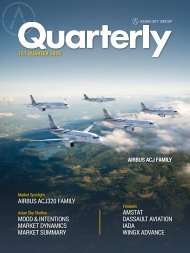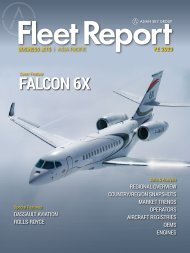Create successful ePaper yourself
Turn your PDF publications into a flip-book with our unique Google optimized e-Paper software.
SPECIAL FEATURE: TRAINING REPORT 2018<br />
PILOT DEMAND<br />
WITH THE NEED FOR INCREASED CONNECTIVITY COMES A GLOBAL DEMAND FOR PILOTS. THE<br />
ASIA PACIFIC LEADS THE DEMAND FOR GROWTH, REQUIRING 261,000 PILOTS BY 2037, ACCORDING<br />
TO BOEING’S 2018 PILOT OUTLOOK. PILOT DEMAND IS DRIV<strong>EN</strong> BY INCREASED NUMBERS OF<br />
PASS<strong>EN</strong>GERS, AIR CARGO AND MORE WIDESPREAD AIRCRAFT UTILIZATION IN VARIOUS FIELDS<br />
INCLUDING FARMING (CROP DUSTING, AERIAL MUSTERING) AND EMERG<strong>EN</strong>CY SERVICES, SUCH AS<br />
PATI<strong>EN</strong>T TRANSPORTATION.<br />
2027<br />
COMMERCIAL<br />
+90,000<br />
Pilots<br />
HELICOPTER<br />
+9,600<br />
Pilots<br />
BUSINESS JET<br />
NOTE:<br />
Airline pilot demand figure source: CAE<br />
Airline Pilot Demand Outlook Report.<br />
+2,850<br />
Pilots<br />
COMMERCIAL<br />
Airlines are the largest driver of pilot demand. According to CAE’s<br />
“Airline Pilot Demand Outlook” report, the annual global passenger<br />
number is projected to increase by 1.6 billion to 4.8 billion by 2027.<br />
More passengers drive aircraft production, which, in turn, drives<br />
demand for more pilots to operate new aircraft.<br />
An airliner is flown by two pilots at any given time; however, extra<br />
pilots are required on long-haul flights to comply with maximum<br />
flight time limitations. Moreover, since pilots typically fly around<br />
15 days a month, pilots need to work in shifts, further increasing<br />
the pilot-per-aircraft ratio. The exact ratio is determined by aircraft<br />
utilization and aviation authority regulations. One regional aircraft<br />
may require 10 pilots, and one wide-body jet may need up to 16<br />
pilots to operate frequent long-haul flights.<br />
Airlines are expected to create jobs for 255,000 new pilots over<br />
the next 10 years in Asia Pacific: 70% of these will accommodate<br />
for fleet growth and the remaining 30% will replace pilots who<br />
retire or switch profession. The Asia Pacific also needs to address<br />
the issue of retiring pilots. With an average pilot age of 46 as of<br />
2016 pointed out by CAE’s report, the industry will lose a good<br />
number of qualified and trained pilots in the coming years as they<br />
reach the mandatory 65 years old retirement age. This means<br />
that the industry will demand not just more pilots overall, but<br />
disproportionately more highly experienced pilots, to place them<br />
into captain positions previously occupied by older employees.<br />
14 | ASIAN SKY QUARTERLY — THIRD QUARTER 2018

















